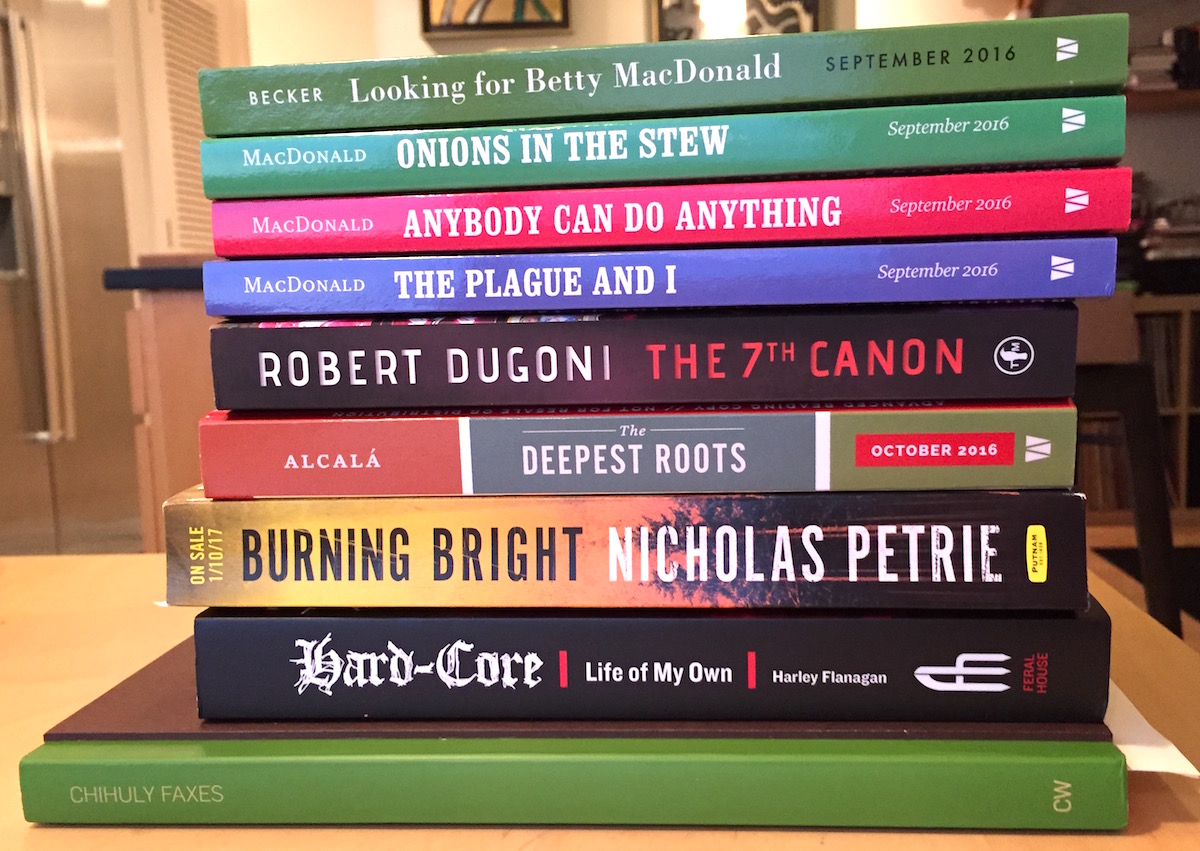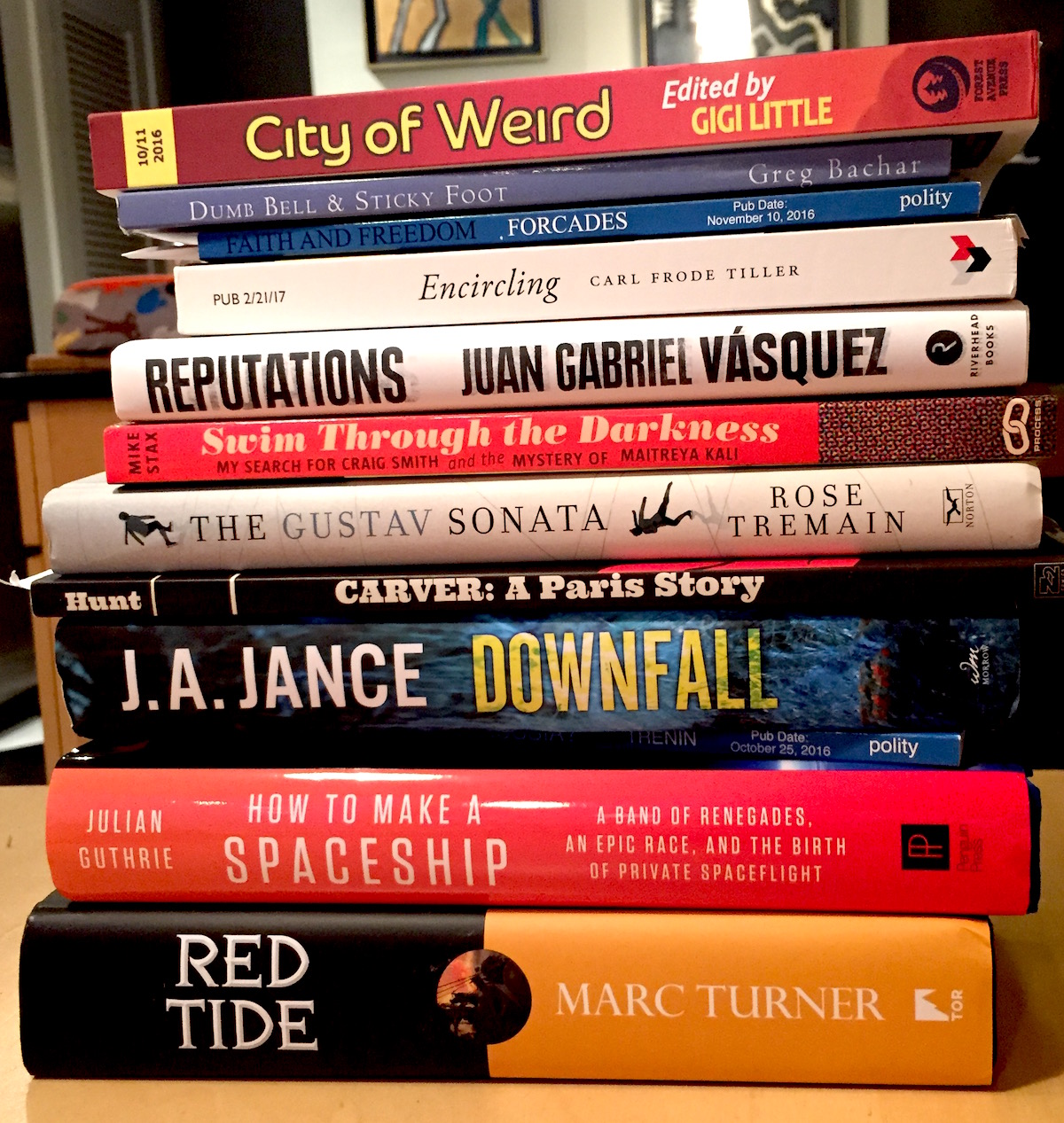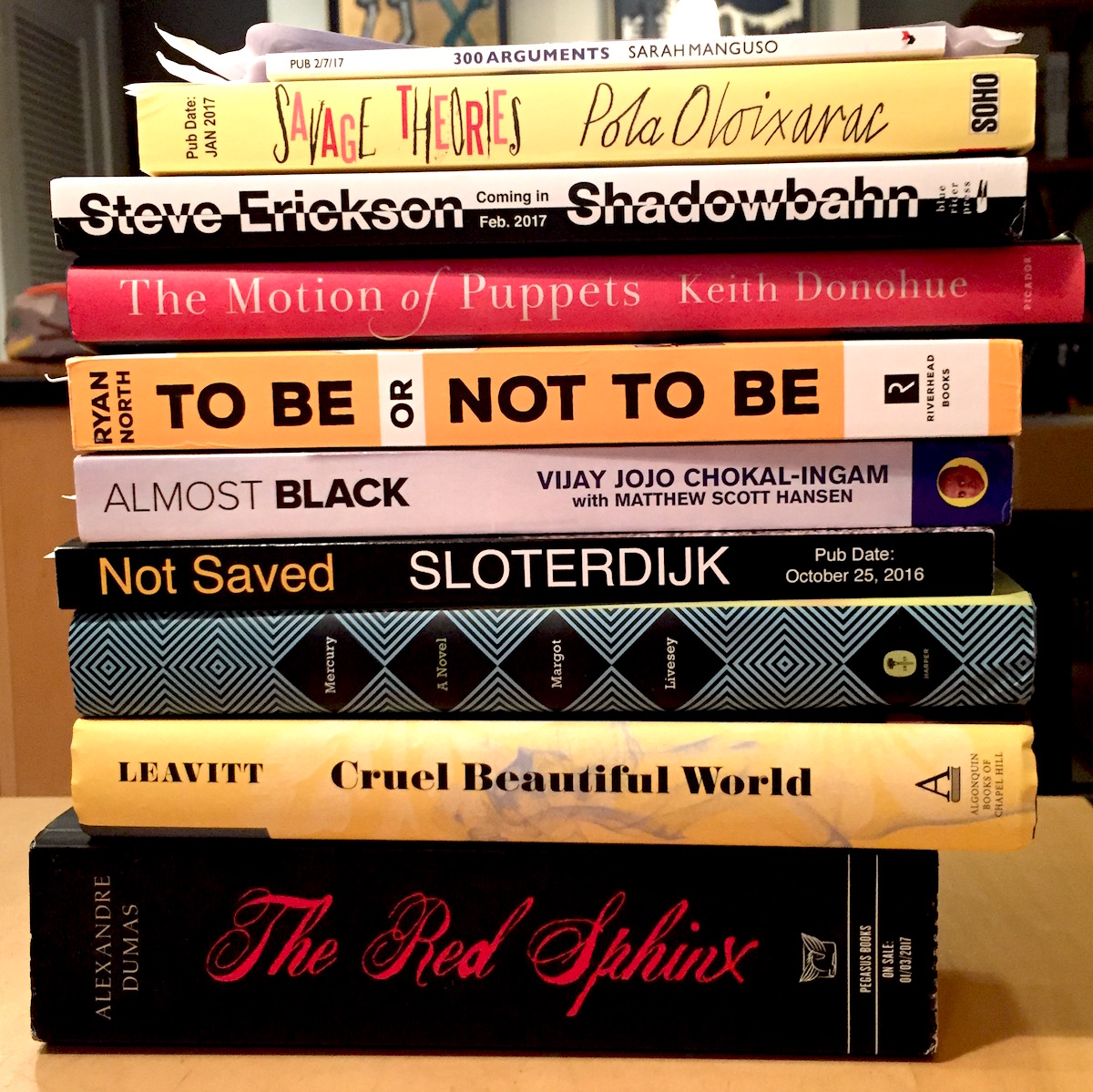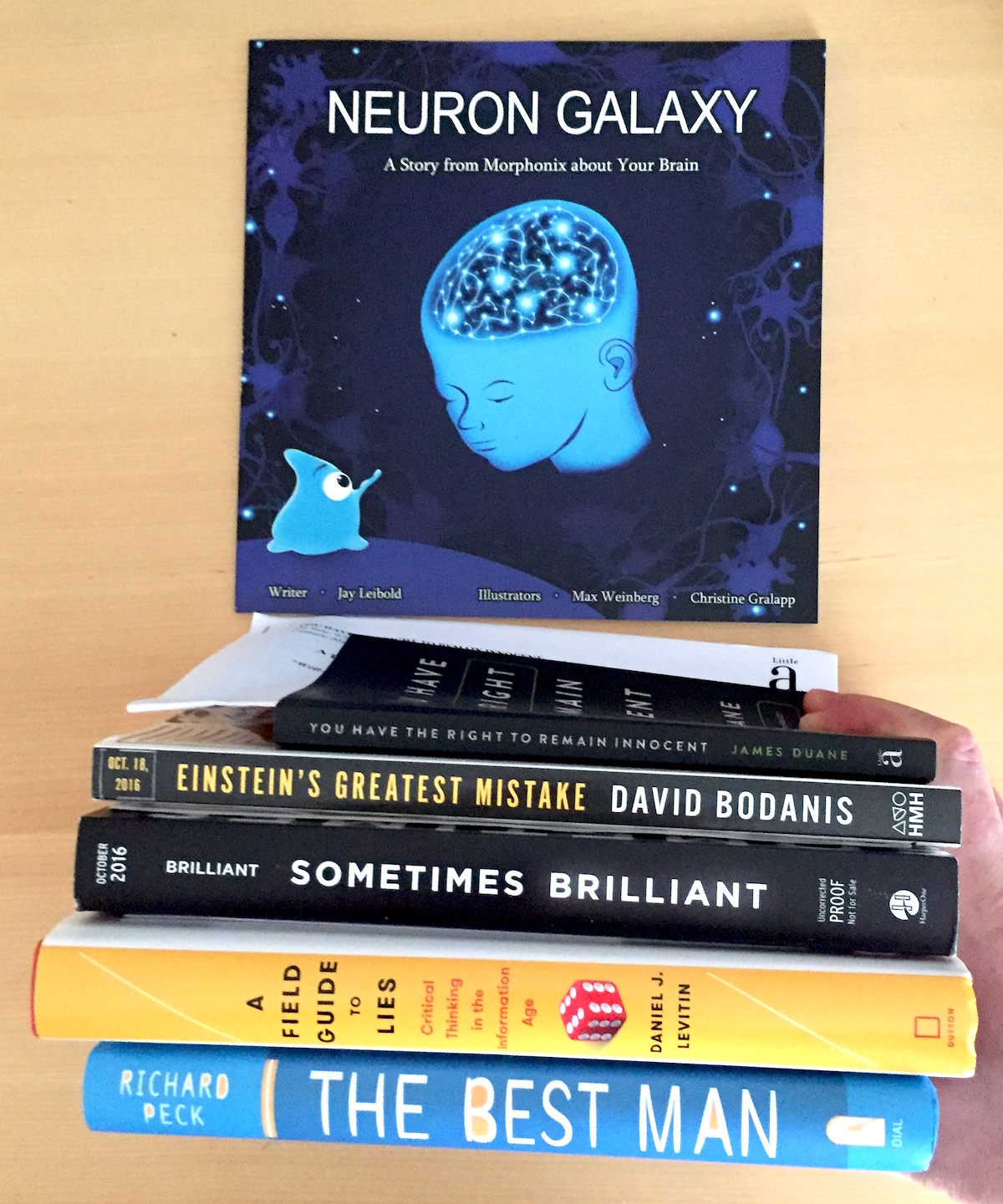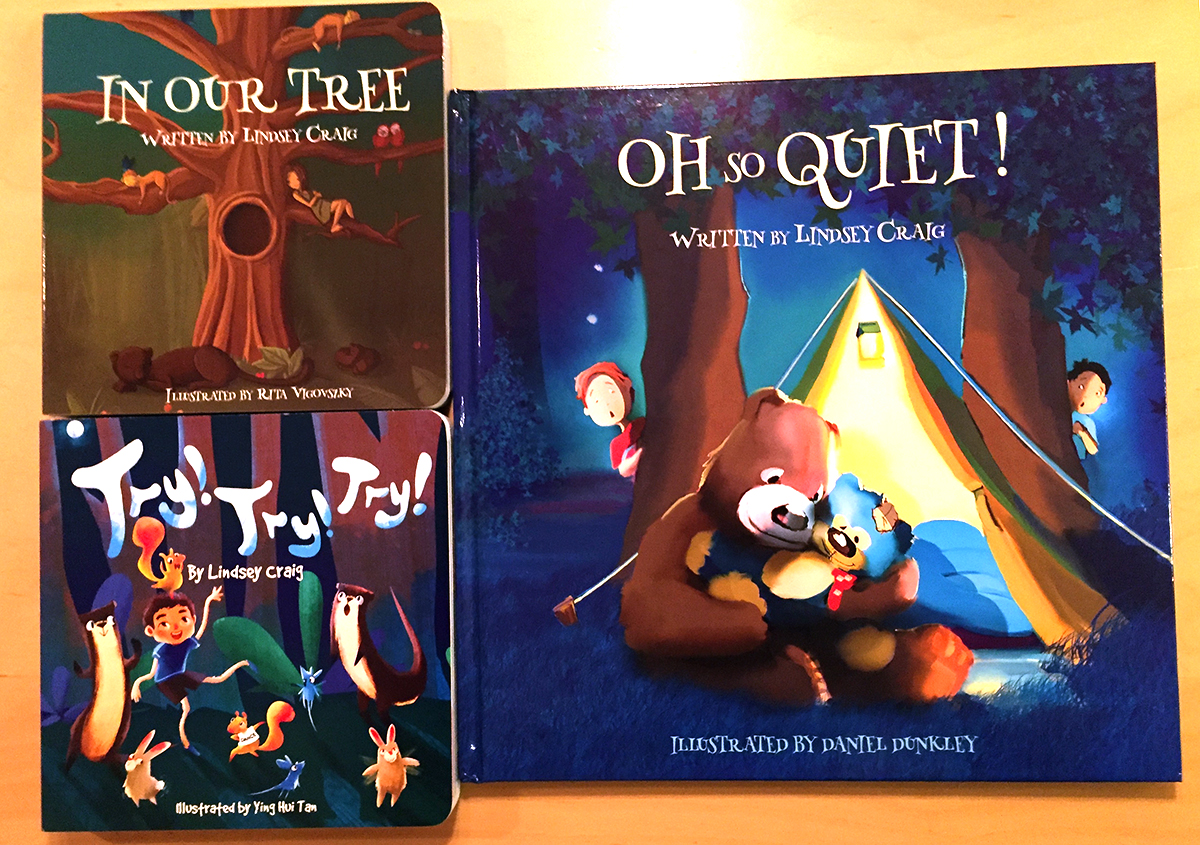On Facebook, the founder of Seattle-area feminist magazine Stackedd, Ma’chell Duma Lavassar, made an exciting announcement: with the help of the good folks at Shunpike, Stackedd has become a nonprofit:
Beginning in January we will become an organization focused on what we do best — promoting women and non-binary folks in the fields of Art and Media. The Magazine will publish online bi-weekly and in print three times a year. In addition, we'll be teaching workshops, presenting forums and continuing and expanding our youth programs.
Always great to see an ambitious player in the loca media landscape.
The Matter of the Balcony Railing
There’s been a lot of talk about the balcony railing lately. Is it up to code? Does it have a soul? What secrets does it hold? Does it have reality? Does it have anyone to blame but itself? What are we to do with it? Why does it have to appear at all? Personally, I don’t really care. It’s not our balcony. But as an external feature of the building we are to share in its fate and responsibility. In philosophy, this is called the problem of identity over time, or the doctrine of preformation. You may remember the balcony scene from Romeo and Juliet. Well, this has nothing to do with that. This is an HOA situation. I feel the slow crackle of metamorphism. This is called hydrothermal alternation. I feel the clutch of the sublime when I say this. There is a balcony in all of us that develops by rumination. It becomes lost in its arabesques. Though perhaps it may be more accurate to say that it comes to itself in its arabesques. It honors the élan of its own extravagance. This is what gives the balcony railing its humor of increasing subtlety, of understatement and overstatement, of empirical dance and dynastic abstractness. Whenever I’m feeling parenthetical it helps to think of something prominent and wet. I think of the balcony railing. Its lucidity and inertia. The convivial curves of its filigree. There’s a certain implication involved in making an appeal to the vitality of carrots. It is, after all, a balcony railing under discussion here and not a catwalk. If this were a catwalk rather than a railing, I might mention decimals, or pylons. There are intermediates in protein metabolism that will serve as motivational tinfoil. Probable impossibilities are to be preferred to improbable possibilities, said Aristotle. But did Aristotle have a balcony? Did Aristotle cook hamburger on an open grill? Did Aristotle own a single spatula? It is enough that the balcony railing strikes the eyes of the passerby with eloquence. Everything else is morality. No one knows what a belief is. No one knows what a truth is. We just go on pretending that the balcony railing has all the answers. And open our books and read.
The specific language of the medical world
Sponsor Barbara E Geary is here to introduce you to her book I Can Speak Medical!, a light and fun introduction to medical terms and speak. Geary was a professional registered nurse, and taught an Introduction to Medical Vocabulary class. She brings that expertise to her great book.
You can read her introduction on our sponsor's page. You'll find the book a great resource — yes, for people entering the medical profession, but also for the layperson who may be encountering the world of medical language and wanting to understand more.
It's thanks to sponsors like Barbara E Geary, and readers like you, that we're able to keep the pixels lit up here at the Seattle Review of Books. We've just released our next block of sponsorship opportunities. Check them out on the sponsorship page, and grab your date before they're gone.
American odyssey
Published September 12, 2016, at 11:59am
Colson Whitehead's novels are all about the alternate realities that keep us from truly understanding each other. In his latest, The Underground Railroad, can he finally find a way to bring us together?
Book News Roundup: Bruce Springsteen's book tour is coming to Seattle
- Bruce Springsteen is doing a reading tour for his new memoir, and he'll be reading at Elliott Bay Book Company on October 1st. Expect a madhouse. Tickets are here.

Wordstock, Portland's annual literary festival, has announced their 2016 lineup, which will take place on November 5th. Highlights include Seattle authors like Maria Semple, Lindy West, and Sherman Alexie, along with national authors like Colson Whitehead, Yaa Gyasi, and Nicholson Baker.
I interviewed director Jeff Feuerzeig onstage at SIFF this summer about his new documentary Author: The JT LeRoy Story. One of the questions I asked had to do with the many phone calls in the documentary: Laura Albert, who pretended to be an author named JT LeRoy for years, recorded all her phone calls, seemingly without the other callers' permission. Many of those recordings are in the film. I didn't record the onstage interview so I don't have Feuerzeig's response handy, but he stood by his film and his treatment of the recordings. This New York Times story indicates that others are unhappy with the very existence of the tapes:
For some people who reviewed transcripts from “Author” provided by The New York Times, the revelation years after the fact that Ms. Albert had been covertly recording phone calls was yet another deception in a trail of mendacity that extended to the late 1990s and early 2000s, when JT LeRoy published “Sarah,” a novel about a 12-year-old truck-stop prostitute, and “The Heart Is Deceitful Above All Things,” linked short stories about an abused boy.
For what it's worth, I was not especially impressed with Author. I thought it was one-sided to the point of almost being a hagiography of Albert. Feuerzeig defended his movie in the interview, referring to it as New Journalism in the style of Tom Wolfe.
Spokane author Kate Lebo published a wonderful essay about gentrification in Seattle on The Rumpus over the weekend. It's titled "Twenty-Three Pieces of the Sunset Bowl" and you should read it. We ran an interview with Lebo on Seattle's many changes last year.
Books aren't the only stories that matter at Lion Heart Books
On my second visit to Lion Heart Book Store, I overheard David entertaining a small audience with a story involving a large caterpillar on an expensive rug. Like with many customers, he remembered me and greeted me by name. Lion Heart Book Store is full of stories, but not only from David’s life and the books that surround him. Visitors seem eager to share their own stories: they tell him about their book collections, their jobs, their favorite novels, their pipe dreams. He listens, he jokes, he relates, but more importantly he shows he cares. He reads people so well he seems psychic (“My mother says I have psychotic powers,” he jokes in his singsong voice) — correctly guessing my dad’s profession and that a woman in the store hailed from Michigan. Love and people are two incredibly important things for this animated shop caretaker, so it only makes sense that my request for a memorable customer story elicited two in-store proposal tales. The stories received several “awwws" from the browsing visitors, punctuated by David’s sung punchline: “If I can’t find love, at least I can help others!”
In front of the cash register leans a small whiteboard titled, “Before I Die I Want To…” Visitors use the marker on the counter and write out their goals and aspirations. Once, a man wrote he wanted to marry and grow old with his girlfriend — writing her name on the board — and wandered between the rows of books. She came up to the counter, saw the whiteboard, and looked at David, who simply nodded. And the two were engaged. The second story takes place in a corner of the store, when a man taped a ring to the inside of a book and proposed.
This tiny whiteboard is but one of several aspects in Lion Heart that show how important customers are and makes an effort to include them, turning every person into an involved visitor rather than a passive browser. The bulky binder of postcards is another testimony, as is David’s attentiveness when finding books for people. He takes everything into consideration when recommending titles. For me, he browsed the shelves, musing, “I’m trying to think of something you’ll like but is different. This one is too heavy for your travels.” Impressed by his thoughtfulness, I soon saw each person receives the same unique attention. He seems to know every last book in his shop, adopting the role of matchmaker and marrying customers with novels. It’s evident this is an important task for him as he looks over spines and covers, singing, “Once you find the right book you will flyyyyyy like a biiiiiiird.”
It is the love for people that places Lion Heart Book Store on the same level as the other shops he respects and admires. Being a part of the Pike Place Market scene allows for unique experiences that other stores aren’t as fortunate to have. Some stories involve following bloody footprints to the bathroom, but to David, being in the market means being surrounded by families and owners who pour their heart into their stores and what they do: it’s not a corporate atmosphere where the face behind a storefront changes daily. Naturally, books are the essence of a bookstore, but in the words of Lion Heart’s amazing owner, “Can you imagine a bookstore without people?”
The Sunday Post for September 11, 2016
Hello Sunday Post readers! Thanks to our intern Rebecca Garcia Moreno for handling your picks of Sunday reads over the Summer. She did a great job. Back now to your regularly scheduled recommenations....
Framed: she was the pta mom everyone knew. who would want to harm her?
Christopher Goffard's absolutely bonkers, and incredible, six-part story from the LA Times, reproduced here in full, about people who do shitty things.
They were outside Plaza Vista School in Irvine, where she had watched her daughter go from kindergarten to fifth grade, where any minute now the girl would be getting out of class to look for her. Parents had entrusted their own kids to Peters for years; she was the school’s PTA president and the heart of its after-school program. Now she watched as her ruin seemed to unfold before her. Watched as the cop emerged from her car holding a Ziploc bag of marijuana, 17 grams worth, plus a ceramic pot pipe, plus two smaller EZY Dose Pill Pouch baggies, one with 11 Percocet pills, another with 29 Vicodin. It was enough to send her to jail, and more than enough to destroy her name.
ART SEEN: Stranded at sea, British artist sees her surroundings with new eyes
Rebecca Moss is an artist that was traveling on a Hanjin ship when the company declared bankruptcy, and now she's stuck at sea and the boat can't arrange to come into port. Kevin Griffin fro the Vancouver Sun has an interview with her.
Rebecca Moss is the British artist stranded on the Hanjin Geneva owned by the Hanjin shipping line that filed for receivership Wednesday. She was on board as part of the 23 Days at Sea Residency organized by Access Gallery in Vancouver.
The Sandy Hook Hoax: Lenny Pozner used to believe in conspiracy theories. Until his son’s death became one.
Lenny Ponzer's six-year-old son was murdered at Sandy Hook. Now, conspiracy theorists keep harassing him, and his family, convinced that his son not only didn't exist, but was a fiction made for some nebulous government conspiracy.
It didn’t take much longer for Pozner to find out that many people didn’t believe his son had died or even that he had lived at all. Days after the rampage, a man walked around Newtown filming a video in which he declared that the massacre had been staged by “some sort of New World Order global elitists” intent on taking away our guns and our liberty. A week later, James Tracy, a professor at Florida Atlantic University, wrote a blog post expressing doubts about the massacre. By January, a 30-minute YouTube video, titled “The Sandy Hook Shooting — Fully Exposed,” which asked questions like “Wouldn’t frantic kids be a difficult target to hit?,” had been viewed more than 10 million times.
POWER & MAGIC: THE QUEER WITCH COMICS ANTHOLOGY - Kickstarter Fund Project #35
Every week, the Seattle Review of Books backs a Kickstarter, and writes up why we picked that particular project. Read more about the project here. Suggest a project by writing to kickstarter at this domain, or by using our contact form.
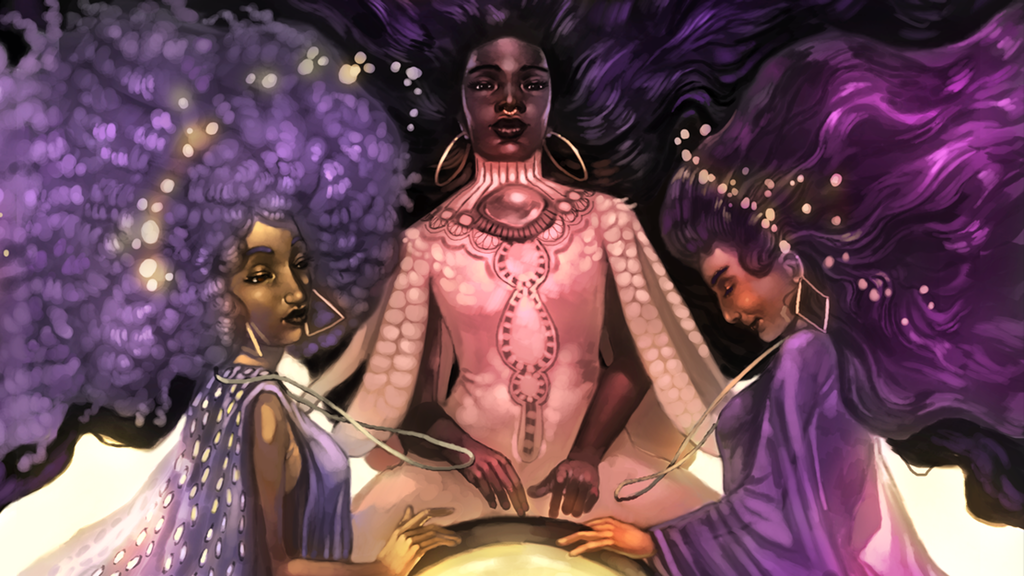
What's the project this week?
POWER & MAGIC: THE QUEER WITCH COMICS ANTHOLOGY. We've put $20 in as a non-reward backer
Who is the Creator?
What do they have to say about the project?
15 comics about queer witches of color, created by 17 women, demigirls, and bigender people of color.
What caught your eye?
I've always loved stories about witches. Out of all the mythical creatures, witches are most relatable because they are fundamentally about how society views women. Unlike vampires, say, that maybe represent a single angle of men, there is a witch for every view of women. They may be good, or evil, benevolent or merciless. But one thing that witches always are: resourceful and independent, two traits society frowned upon in women, historically.
And more so for women of color. So yes: more stories about witches. And yes: more stories about queer witches of color. It's a great premise, and from the artwork on the site, and the list of contributors (uh, the coven, although counting the cover design I count 15 projects in this piece, so maybe it's a baker's coven) is strong and interesting.
Why should I back it?
Comics! Witches! Queer witches! Queer witches of color! I mean, need I say more?
How's the project doing?
30% funded with 28 days to go. Good trajectory, but let's see if we can help them out and spread the world. Every bit helps.
Do they have a video?
Kickstarter Fund Stats
- Projects backed: 35
- Funds pledged: $680
- Funds collected: $600
- Unsuccessful pledges: 2
- Fund balance: $340
Eugene Kim at Business Insider writes:
Amazon is aggressively expanding its presence in the real-world retail market, with a plan to open dozens of new pop-up stores in US shopping malls over the next year, a source familiar with the matter told Business Insider.
These stores mostly seem to be device sales locations, not bookstores. Meanwhile, Barnes & Noble's founder and interim CEO calls the retail environment "one of the worst I have ever experienced in the 50 years I have been in this industry."
Book News Roundup: Featuring Patton Oswalt, Hillary Clinton, Gabriel Garcia Marquez, and a whole lot of writing opportunities
Children's book author Jonathan Tweet debuts his new children's book about evolution, Grandmother Fish at Ada's Technical Books tomorrow morning. It's free; you should go! If you'd like to learn more about the book, our friends over at Nerdhole published a podcast interview with Tweet that is absolutely worth your time.
Colombia is releasing Gabriel Garcia Marquez banknotes starting next month. They look like this:

Now is the time to register for the spring edition of YAWP, which stands for Your Alternative Writing Program. It's a Port Townsend-based community retreat for established and aspiring authors, and registration costs less than two hundred bucks.
This has been rumored for a while, but it's finally official: independent comics publisher Image Comics is moving from San Francisco to Portland, OR. Between Image, Dark Horse, and Oni Press, Portland is now home to three of the largest comics publishers in the country.
The travel-minded folks at Atlas Obscura just opened a Seattle office, and now they're looking for a few Seattle-area "enthusiastic adventure nerd[s]" to be field agents. If you know a lot about Seattle past and present, and if you like leading tour groups and being obsessed with history, you should apply for this position.
Hillary Clinton is a big fan of Elena Ferrante's books, calling the bestselling author "just hypnotic." Donald Trump doesn't read.
The flash fiction magazine SmokeLong is accepting applications for the Kathy Fish Fellowship, which is a virtual writer-in-residence position that comes with a cash prize and "the opportunity to work with SmokeLong staff and participate in online writing workshops" for the year of 2017. Applications close on September 15th.
Did you know that Seattle-area cartoonist David Lasky used to make cartoons with stand-up comedian Patton Oswalt back in his college days? It's true!
Get a load of this gorgeous 360-degree anti-Trump comic made by Seattle cartoonist Eroyn Franklin.
The Help Desk: Hypocrisy is so much cheaper when you buy it online
Every Friday, Cienna Madrid offers solutions to life’s most vexing literary problems. Do you need a book recommendation to send your worst cousin on her birthday? Is it okay to read erotica on public transit? Cienna can help. Send your questions to advice@seattlereviewofbooks.com.
Dear Cienna,
I refuse to buy books from Amazon, either in physical or ebook format. The way they shut down bookstores was morally reprehensible.
But I’m ashamed to even type this — I buy everything else from Amazon. Groceries, bedding, electronics. I even got an Echo recently, and now I talk to Alexa when I’m home alone with the thing.
I’ve built up this hypocritical firewall in my brain that somehow just because I buy my diapers and detergent from Amazon, my money isn’t going to the books portion of the company. I’m just lying to myself, right? I’m putting bookstores out of business because I like things to be convenient. Should I pack up Alexa and put her in the garage?
Claudia, Fremont
Dear Claudia,
Here is a brief list of people more hypocritical than you:
- Football fans who scream "Constitutional freedom!" when it comes to their guns but condemn quarterback Colin Kaepernick for opting out of the national anthem.
- Animal lovers who kill spiders.
- Any feminist who has thought about Paul Ryan's abs while in bed.
- Everyone who loves children so much they let them make all of their clothing and electronics.
It's easy to identify values that resonate with us but nearly impossible to live by them all, so we pick and choose our favorites. For instance, I espouse a healthy basement lifestyle: every morning I start my day with six crunches and a half-minute of calisthenic door squats. At bars I brag to attractive strangers that I am healthy, very popular with introverts, and have never given birth to anything human.
But as my spiders like to point out, only half of them are introverts and my eating habits are actually pretty unhealthy – I have a serious sweet tooth. They say sugar is poison, I say they drink too much, and here we are at an impasse: Who is actually healthier and why do I routinely find myself with a mustache full of cookie crumbs, arguing with wine-soaked spiders about type 2 diabetes on a Friday night?
That is my cross to bear. Yours is the albatross of Amazon.com. For what it's worth, I doubt local booksellers care where you buy your diapers. If you're trying to support local booksellers, buy books from them. Boycotting Amazon, while symbolic, won't pay their rent. (If it helps, I've found chanting, "I condemn thee" at my cookies before I eat them makes me feel better about my personal choices.)
And don't let Alexa control your life. The lights, maybe, but make sure to draw the line somewhere.
Kisses,
Cienna
Portrait Gallery: Robert Lashley
Each week, Christine Marie Larsen creates a portrait of a new author for us. Have any favorites you’d love to see immortalized? Let us know

Robert Lashley, current Stranger Genius nominee and Jack Straw Writing Fellow, will be reading this Tuesday at University Book Store. Trust us. You want to see Lashley read.
Thursday Comics Hangover: Margaret Atwood's first comic, Angel Catbird, is not very good
Margaret Atwood deserves the Nobel Prize for Literature. She’s written some of the best books written in English over the last fifty years and her range far surpasses most of her American contemporaries, stretching from science fiction to literary fiction and back again. She’s an underrated poet. And she’s terrific on Twitter. So when Portland comics publisher Dark Horse announced that they would be publishing Atwood’s first comic, Angel Catbird, in the fall of 2016, I was understandably excited. The news that Angel Catbird would be drawn by Johnnie Christmas, and up-and-coming comics artist of the Image Comics series Sheltered, made the book sound even more appealing.
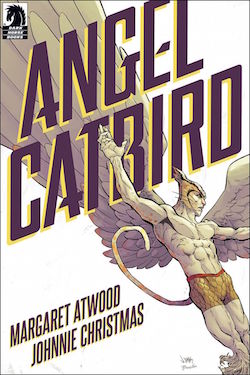
Now Angel Catbird is finally on the stands and, uh, well. Even one of the world’s best writers can’t be great at everything. The plot is standard superhero boilerplate: a scientist named Strig Feleedus is working on a miraculous “super-splicer serum” that will cure diseases by “replacing damaged genes with healthy ones.” Feleedus winds up in an accident that splices his genes with that of a cat and an owl, turning him into a human-bird-cat hybrid. Soon, with the help of a secret society of pun-obsessed half-cats, he’s fighting a human-rat hybrid who wants to take over the world or something.
This is not to say that Angel Catbird doesn’t have its moments. A few of the best jokes in the book demonstrate Murakami-level blending of non sequiturs with a painfully dry delivery. (To transform from his catbird form back to human, Feleedus thinks of a washing machine, because “you ever met a cat who likes washing machines?”) But those amusing moments of self-awareness are rare, and buried under metric tons of awkwardness. The love interest is a half-cat named Cate Leone who is in a band called Pussies in Boots who sings songs with lyrics like this: “You are my dish of cream…you are my catnip dream…you are my midnight scream, it’s true.”
In fact, most of Angel Catbird’s troubles are inside the word balloons. The dialogue is wooden and borderline moronic. On the very first page, Feleedus offers a wall of exposition to his housecat:
Don’t want your buddy to be late for his new job! Seeing as I was head-hunted and all—for a top secret project! Very important! I know you don’t like it, but someone’s gotta pay for the cat food!
It’s so clunky and dumb and arrhythmic that it almost feels like an aesthetic attempt toward purposeful artificiality, like the on-the-nose dialogue in a Hal Hartley film. But there’s nothing under the surface to discover, no deeper meaning to the stilted dialogue. It’s just…really bad comics dialogue.
Here’s the villain after he causes the accident that will eventually lead to Angel Catbird’s creation: “Exit Feleedus! My digitally controlled rat slave was the perfect lure! I’ve destroyed the only sample! Tomorrow I’ll grab the formula off his computer! And enter the age of the rat!” So many exclamation points! It's hard to believe an editor allowed this to happen! If the book was even edited at all!
For a few pages, I tricked myself into thinking that perhaps Atwood was writing Angel Catbird for young audiences; the bad dialogue wouldn’t be excusable if that were the case—kids deserve good writing, too—but it would at least be understandable in the context of a clueless adult talking down to kids. But there are too many sex jokes in Angel Catbird for the book to be intended for very young audiences; in the end, I have no idea who this book is supposed to be for, aside from indiscriminate Atwood fans.
At times, and if you look at it from a certain angle, you can see a sort of cheeky old-school comics aura around Angel Catbird. Atwood occasionally sprinkles trivia about cat and songbird wellness throughout the book, which brings to mind the science trivia that used to appear in silver age Flash comics as “Flash Facts.” But if that is, in fact, Atwood’s goal then she’s embracing the wrong traits of old comics — the atrocious dialogue and thought balloons, the facile motivations — and ignoring the vitality that made those books so compelling. In a year that’s seen some excellent mainstream writers successfully make the leap to the world of comics (Ta-Nehisi Coates, William Gibson) Atwood’s first venture into comics is a fairly spectacular failure.
Our response to the Public Diversity Editor Report #1, September 2016
Yesterday we published our first report from our Public Diversity Editor, Vanessa Willoughby. As promised, we published it with minimal stylistic editing, all of which Vanessa approved before publication.
Why are we publishing a diversity report? It's a question worth asking again, and the answer is simple: either you think that the world is just and that the inequalities experienced in our society (or, more acutely, in the publishing world) by people of color, women, and LGBT people are because of their inherent lesserness, or you accept that bias and privilege are real.
That means, as two white male cofounders, we have unconscious biases. Since they're unconscious, we're by definition not aware of them. Anybody who has ever had a friend or loved one point out something blindingly obvious in their personality, that they missed, will agree that humans are complex, and we don't always see ourselves clearly. We have tremendous cognitive biases. When someone points out where you are failing, that does not somehow make you weak — instead, it allows you to correct the failure and become stronger.
One thing that's difficult in addressing diversity is looking past quota or color. The first reaction to realizing you have very few black writers in your publication is to look for black writers. But doing so misses the point of inclusion, where Vanessa rightly pointed out our focus should be. We're not trying to get a cookie or do something good for good's sake, we're trying to broaden the point of view of our writers and the people we write about.
That means not looking for x black people, or x gay people, or x women, but spending time reading people of color, say, to find voices that resonate with us, and then reaching out. We shouldn't hire somebody because they're a person of color, we should push ourselves to read broadly among people who fall into those groups, and discover those voices that speak to us, within circles we otherwise may not have travelled.
The people we publish are not a quota, they are individuals with viewpoints, aspirations, and biases of their own, and widening our circle by including them makes the varied points of view we publish more interesting. If, with their help, we lean away from the mean of the history of publishing, that strengthens us.
The only thing we missed seeing mention in Vanessa's report this time was how we did with inclusion of LGBT folks and issues. We have published pieces by or about genderqueer and trans writers, from gay and lesbian points-of-view, and from bisexual writers as well. We want to make sure that these writers are considered as well in Vanessa's next report.
But other than that critique, we have taken her report in the spirit it was offered, and are considering ways that we can do better. Not, again, for a reward or pat on the head, not because it's the "right" thing or because it matches or progressive values. We do it because the history of publishing is the historical story of mostly white men, and as white men, we're fed up with them. We want our work to be better, broader, deeper, and more resonant.
Thanks to Vanessa for her work on this, and thanks to you for reading. We're always happy to hear what our readers think; we hope that Vanessa has started a conversation you'll want to join.
Your Week in Readings: The best literary events from September 7th to September 13th
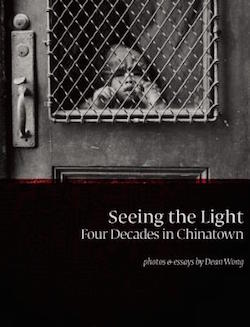
Wednesday September 7th: Seeing the Light: Four Decades in Chinatown
Dean Wong has devoted his life to recording the Asian-American experience through photos and words. His latest book, from Seattle-area publisher of beautiful books Chin Music Press, is a tribute to Chinatowns all over North America. Wong’s interviews and portraits capture the spirit of community that makes Chinatowns from coast to coast more than just neighborhoods.Third Place Books Seward Park, 5041 Wilson Ave S, 474-2200, http://thirdplacebooks.com. Free. All ages. 7 p.m.
Thursday September 8th: Too High & Too Steep: Reshaping Seattle’s Topography
David B. Williams’s book is about how Seattle’s earliest white settlers decided the geology of the region is what you’d call a fixer-upper. From the Denny Regrade to what’s really underneath Pioneer Square, Williams will talk about all the ways we’ve torn Seattle apart in order to build Seattle up. Town Hall Seattle, 1119 8th Ave., 652-4255, townhallseattle.org. $5. All ages. 7:30 p.m.Friday September 9th: One Nation Under God
Kevin M. Kruse is the evangelical right’s worst nightmare: a professor from Princeton who has written a book that unveils the fairly modern invention of the lie that America is now and has always been a Christian nation. Kruse argues convincingly that our national obsession with a Jesus-created America began in the 1950s. Town Hall Seattle, 1119 8th Ave., 652-4255, townhallseattle.org. $5. All ages. 7:30 p.m.Saturday September 10th: Stomp the Patriarchy Ball
Seattle-based all-ages arts organization The Vera Project teams up with abortion awareness organization #ShoutYourAbortion to celebrate the one-year anniversary of #SYA, featuring bands, DJs, a photobooth, and readings from three of the most important writers in town right now: Hollis Wong-Wear, Ijeoma Oluo, and Lindy West. Patriarchy’s balls are in for a terrific stompin’. Washington Hall, 153 14th Ave, http://washingtonhall.org. Pay what you can. All ages. 8 p.m.Sunday September 11th: The Esoteric Book Conference
Say what you will about how Kindles are lighter than physical books; there will never be any such thing as an esoteric ebook. This international book festival offers new and used books devoted to out-of-the-ordinary knowledge. The seminars and presentations cost money, but the book fair and art show are free. William H. Foege Hall, Genome Sciences Building, University of Washington, http://esotericbookconference.com. Free- $60. All ages. 9 a.m.Monday September 12th: Sleeping on Jupiter
See our Event of the Week column for more details. Elliott Bay Book Company, 1521 10th Ave, 624-6600, elliottbaybook.com . Free. All ages. 7 p.m.Tuesday September 13th: Jack Straw Writers
The Jack Straw Writers Program aspires to teach Seattle-area writers how to better present their work both live and on recorded audio. Tonight, three 2016 Jack Straw Writers, including poets Alison Stagner and Carolyne Wright, singer Shontina Vernon, and poet Robert Lashley, who is rightfully enjoying a hell of a year in the Seattle-media spotlight. University Book Store, 4326 University Way N.E., 634-3400, http://www2.bookstore.washington.edu/. Free. All ages. 7 p.m.Literary Event of the Week: Sleeping on Jupiter at Elliott Bay Book Company
And so here we are, at the beginning of a shiny new fall. Fall is to the literary world what summer is to movie season: the season when the big names come out to play, when the big advertising budgets and media blitzes roll out. And every season, the books are accompanied with a certain amount of buzz—book chat, both positive and negative, from agents, librarians, and other literary folks with early access to review copies.
Sometimes, these books are instant classics, the kind of reading experience that engages even people who don’t pay that much attention to books. But as with summer blockbusters, sometimes that hype amounts to not much at all. Duds collide with runaway bestsellers, famous authors sometimes fail to impress their beloved fans, and new writers appear from (seemingly) nowhere to become household names.
This year, we’ve got new books from Zadie Smith, Michael Chabon, Maria Semple, Jonathan Safran Foer, Bruce Springsteen, and many more on the way. Thanks to Oprah’s pre-publication endorsement, we’ve already seen Colson Whitehead’s Underground Railroad become one of 2016’s rare must-reads. (Speaking of which: Hugo House is bringing Whitehead to Seattle Public Library on September 17th. Save that date.) It’s all almost too exhausting to think about.
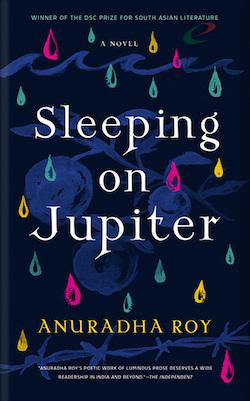
Jupiter begins with our protagonist, Nomi, witnessing her father’s murder:
When the pigs were slaughtered for their meat they shrieked with a sound that made my teeth fall off and this was the sound I heard soon after my mother cut the grapefruit, and the men came in with axes…In my sleep I hear the sound of pigs at slaughter, the sound my father made.
Nomi is adopted and moves to Norway; she comes back to India a grown woman with a project in mind. The book addresses sexism and homophobia and masculine violence in a new way; it’s a novel that pushes at its culture as a force of modernity.
Jupiter has already been nominated for a Man Booker Prize and it’s won and been shortlisted for a bunch of other huge literary awards. And if you think that awards don’t mean anything—you’re only partly right, by the way, but that’s an argument for another time—you should know that the book buzz on this one is off the charts. Local booksellers can’t stop gushing over Roy’s latest, and booksellers are rarely wrong. Jupiter is that rarest of novels: a fiction that serves as an agent of social change. That’s hype you can believe in.
The stars (and Greenwood) my destination

It’s a big day for astronauts and young writers; the Greenwood Space Travel Supply Company is finally reopening, about half a year after the gas explosion that tore up the heart of Greenwood. The Space Travel Supply Company is the retail front of the Greater Seattle Bureau of Fearless Ideas, which is a nonprofit organization that teaches young people how to communicate their ideas through writing, tutoring, workshops, and field trips. If you're unfamiliar, the Space Travel Supply Company is exactly what it sounds like: a store full of space-themed novelties, decorations, and toys, with all proceeds going to fund the BFI.
Seattle poet Sarah Galvin was hired to be the Space Travel Supply Company store coordinator at the end of August. Before she started, BFI employees had already cleaned out the post-explosion mess—“the blast blew the windows out and left everything covered in glass and dust,” Galvin told me over Facebook chat. By the time she started on the job, “everything was clean and boxed up” and ready to be reassembled.
The process of rebuilding the store, Galvin says, was “like putting a puzzle together.” Using old photos of the shop and the memories of former employees, they inventoried all the products and placed them back on the shelves, in as close an approximation of the old store as possible.
So now that the shop is up and running again, Galvin is looking to the future. Anyone who’s attended one of her readings knows that she’s a natural-born party planner who loves a good theme and totally commits to the pursuit of fun. “I can't wait to plan parties, fundraising events,” classes, readings, “and field trips for the students,” she says. “I've always had to gather my own resources to do stuff like that, so I'm VERY excited that it's my job now.”
And Galvin is thrilled that the events she gets to plan will inspire young people to write: “I just want to make the experience as fun and exciting for them as possible because I remember how magic it was when I first discovered writing. I've never wanted my own kids, but I adore the idea of giving someone else the encouragement my elementary school teachers gave me.” For a whole new generation of writers, their journey will start in a small Greenwood storefront packed full of astronaut ice cream, toy rockets, and maps of the known universe.
Public Diversity Editor Report #1, September 2016
Almost half a year ago, we put out an open call for a Public Diversity Editor. After fielding many responses, Vanessa Willoughby accepted our offer to take the role. This is her first report.
The demand for diversity in the publishing world has always been a priority for writers and readers of color. In the past few years, such misrepresentation has become a favorite talking point of media and industry figureheads alike without active solutions. According to a 2015 diversity baseline survey conducted by children’s book publisher Lee and Low, “the number of diverse books published each year over the past twenty years has been stuck in neutral, never exceeding, on average, 10 percent.” The majority of the conversation seems to focus on why books and publishing are so white, and not ways to change the monolithic status quo.
The imbalance in representation cannot change if the parties that consciously or unconsciously enable it never claim accountability. The representation on the Seattle Review of Books website does not overtly perpetuate the industry’s lack of diversity, nor does it maintain an above average level of diversity. This is not to say that SRoB never features authors and/or bylines from people of color. The Portrait Gallery column is not a devotional shrine to the expected cannon: old, dead, white guys. Saturday’s Kickstarter Fund has backed projects by underrepresented groups specifically looking to preserve pieces of their culture and/or make their voices heard above the white noise. For example, I was delighted to see that SRoB had backed the New Poets Project helmed by Copper Canyon Press. Funding is certainly one of the obstacles that blocks writers of color from gaining the same visibility as their white, well-connected peers.
Additionally, SRoB is open to admitting when mistakes or oversights are made. In an industry where many influential players respond to the call for diversity with silence, SRoB is open to criticism. This is apparent in decisions such as publishing Donna Miscolta’s essay about minority representation in the Seattle: City of Literature anthology. Co-founder Paul Constant confessed, “But the truth is, I’m writing this Note because I’m a contributor to Seattle: City of Literature, and I have to acknowledge my part in the book’s failure to represent minorities.” The conversation was continued with the publishing of a letter to the editor from author Kathleen Alcalá that responded to Miscolta’s essay.
On the other hand, both of the aforementioned groups could expand beyond their current demographics. On staff, the split between identified genders seems to fall in line with assessments from Lee and Low: at 71 percent (59 tallied), the majority of editorial staffs are women. Men account for 28 percent (23 tallied). In terms of race, the majority of the staff identified as White or Caucasian. Groups that accounted for one writer, as self-identified, were the following: Native American, Filipino, Chinese, and Latino. Although some responded as biracial or multiracial, non-white groups typically had, at the most, two people and contained less than 10.
Of the writers featured on the site, around 68 percent were white. The overwhelmingly majority of writers were also American. In terms of gender, the difference between the number of men and women writers was small. There were 426 writers total; 211 were male and 215 were female.
In a recent Hollywood Reporter interview with Ava DuVernay and Oprah, the women discussed the downside of aiming solely for “diversity.” DuVernay prefers the word “inclusive,” and explained, “Forward-thinking people and allies of this cause within the industry have the common sense to know that this is systemic…There needs to be more done than applauding one or two people who make it through your door.” Whether it be diverse representation in film or a diverse workplace, sometimes diversity doesn’t necessarily mean equality. A company could mistakenly believe that they’re diverse because they have a few people of color in an otherwise very white staff.
It would be inaccurate to say that SRoB is devoid of any writers who do not identify as white. Yet if publications want to get better about representation of non-white people, the goal needs to be elevated from meeting a low-stakes diversity quota. The writer coverage on SRoB has a few people of marginalized groups, such as Dinaw Mengestu (Ethiopian American), N.K. Jemisin (African American), Victoria Chang (Asian American), and Junot Díaz (Dominican American). However, there’s a danger in settling on the bare minimum qualifications to be deemed “diverse.” The systemic racism that DuVarney mentions in her HR interview can only be dismantled by disavowing a publishing culture that favors a white majority.
Unlike other publications, SRoB has taken the first step forward in discouraging a dominantly white publication. The way in which individuals define their identities does present the reality that representation will always be imbalanced to a certain degree. SRoB’s inclusiveness could be expanded to not just race, but sexuality and those who identify as disabled.
Inclusiveness means that whiteness cannot claim overwhelming dominance and that voices of marginalized groups are not forced to be happy with representation that amounts to the appointment of designated spokespeople. Honesty and self-awareness are necessary requirements of editors who want to end the institution of whiteness within publishing. It’s not enough that publishers put out a handful of diverse books; the people behind the decision making process must be held accountable. Speaking to Broadly about publishing’s diversity problems, Sulay Hernandez, owner of Unveiled Book Development, pointed out: “the majority of books that are published in the US are not by people of color. The majority of high-profile authors are not people of color. So what we want is more voices of color being published and more voices of color being published well. And, very importantly, selling well.”
In the original call for a Public Diversity Editor, SRoB stated, “We thought one way to guard against us succumbing to our own unconscious biases would be to hire an outside person to check our work and report back to our readers.” When author Alexander Chee participated in a virtual roundtable conducted by Antonio Aiello on behalf of PEN America, he asked important questions in relation to diversity. He asked publishers, “What rooms are you in? What conversations? Who are the people in your social media feeds? When you go home, is your family all white? When you go to a party, are your friends all white? When you look down your bookshelf, are all your books by white authors?” I hope that SRoB considers these questions when assessing and retooling their representation of minority and marginalized literature, writers, and industry figures.
